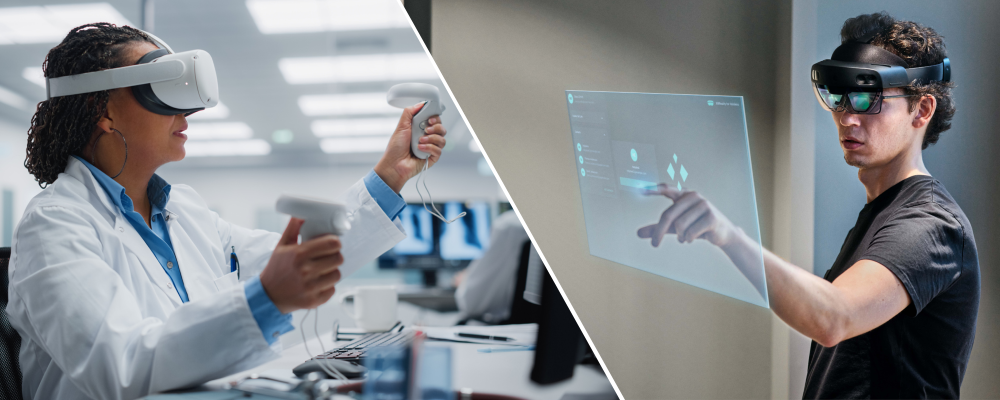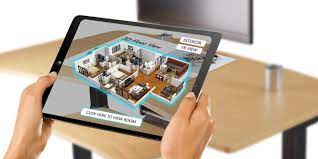AR and VR real estate
Welcome to the future of real estate! In a world where technology is rapidly advancing, the use of Augmented Reality (AR) and Virtual Reality (VR) is revolutionizing the way we buy, sell, and experience properties. Gone are the times of essentially perusing static pictures or taking actual visits. With AR and VR, you can now immerse yourself in a virtual world where you can explore homes as if you were actually there. Whether you’re a buyer, seller, or agent, these cutting-edge technologies offer endless possibilities and benefits that will reshape the real estate industry as we know it. So fasten your seatbelts because we’re about to take an exciting journey into how AR and VR are transforming real estate like never before!
What is AR and VR?

AR, or Augmented Reality, is a technology that overlays digital information onto the real-world environment. It enhances our perception of reality by adding computer-generated elements such as images, videos, and 3D models to what we see through devices like smartphones or smart glasses. Imagine being able to look at an empty room and instantly visualize how it would look with different furniture arrangements or wall colors – that’s AR in action!
On the other hand, VR, or Virtual Reality, creates a completely immersive experience by simulating a virtual world. With the help of specialized headsets or goggles, users can enter into a computer-generated environment where they can interact with objects and explore spaces in a seemingly real way. This technology transports you to another place entirely – whether it’s touring a home from thousands of miles away or experiencing architectural designs before they’re even built.
Both AR and VR are transforming the way we perceive and interact with our surroundings. They have immense potential in various industries including gaming, healthcare, education – and now real estate! These technologies offer exciting new possibilities for buyers and sellers alike by providing realistic visualization tools that go far beyond static images or traditional property tours.
AR enhances our existing reality by overlaying digital information onto it while VR creates an entirely immersive virtual experience. Together they form powerful tools that are reshaping the future of real estate transactions.
What are the benefits of using AR and VR in real estate?

When it comes to buying or selling a property, one of the biggest challenges is being able to visualize the space. This is where AR (Augmented Reality) and VR (Virtual Reality) come in. These technologies have revolutionized the real estate industry by providing immersive experiences that allow potential buyers to explore properties without physically being there.
One of the main benefits of using AR and VR in real estate is that it saves time and money for both buyers and sellers. Instead of having to travel long distances to view multiple properties, buyers can simply put on a VR headset and tour homes from the comfort of their own living room. This not only eliminates the need for costly travel expenses but also allows buyers to narrow down their options more efficiently.
Additionally, AR and VR provide a level of convenience that traditional methods cannot match. With AR, potential buyers can use their smartphones or tablets to superimpose virtual furniture onto empty rooms, giving them a clear idea of how the space would look once furnished. This helps buyers make informed decisions about whether a particular property meets their needs before even stepping foot inside.
Furthermore, these technologies enhance communication between agents, developers, and clients. By utilizing 3D models created with AR or VR technology, agents can showcase properties remotely and provide detailed information about each feature in real-time. This streamlines the process for everyone involved while ensuring accurate representations are provided.
Another advantage is that AR and VR enable customization options for potential homebuyers. With virtual tours or interactive simulations powered by these technologies, customers can personalize floor plans or select different finishes such as paint colors or flooring materials before making any commitments – saving time on renovations later!
In conclusion,
the benefits of using AR and VR in real estate are numerous: time-saving opportunities for both parties involved; enhanced convenience through augmented reality tools like superimposing furniture into spaces; improved communication between stakeholders thanks largely due advancements made possible through 3-D modeling capabilities; increased customization potential through virtual tours that allow for personalization options.
How can AR and VR be used in real estate?

- Virtual Property Tours: AR and VR technology allow potential buyers to take virtual tours of properties without physically visiting them. With a VR headset, users can navigate through rooms, explore different angles, and get a realistic sense of the space. This recoveries time for the two purchasers and merchants.
2. Interior Design Visualization: AR can help clients visualize how their furniture or decor will look in a space before making any purchases. By overlaying virtual objects on real-world environments, clients can experiment with different styles and layouts to achieve their desired look.
3. Remote Collaboration: AR and VR enable real estate professionals to collaborate remotely with clients or colleagues on projects. They can share 3D models, make annotations, discuss design ideas in real-time, regardless of geographical location.
4. Off-Plan Property Previews: Developers can use AR to provide potential buyers with interactive experiences of off-plan properties that haven’t been constructed yet. Buyers can walk through the property virtually and make informed decisions based on accurate representations.
5. Enhanced Marketing Materials: By incorporating AR or VR elements into marketing materials such as brochures or websites, real estate agents create immersive experiences for potential buyers. This allows them to showcase properties more effectively and attract a wider audience.
6.Safety Training for Construction Workers :AR/VR technology is used in training construction workers by simulating dangerous scenarios in order to prepare them mentally & physically before they face those situations at work.
In summary,
AR and VR have revolutionized the way we experience real estate by offering virtual property tours, aiding interior design visualization, enabling remote collaboration between professionals across distances,and enhancing marketing efforts.
They also play an important role in safety training for construction workers.
AR/VR technologies are changing the landscape of the industry by providing innovative solutions that save time,money&effort while improving customer engagement&experience.
In conclusion,the usage possibilities are vast,and as technology continues to advance,we can expect AR and VR to become even more integral
Are there any drawbacks to using AR and VR in real estate?

Drawbacks of Using AR and VR in Real Estate
While augmented reality (AR) and virtual reality (VR) have transformed the way real estate is experienced, there are a few drawbacks to consider. The cost of implementing AR and VR technology can be quite high for individual agents or smaller firms. The equipment, software development, and maintenance expenses can be significant.
Another challenge is the learning curve associated with using AR and VR tools. Real estate professionals need to invest time in training their staff on how to properly use these technologies. This can hinder productivity initially as employees adjust to the new systems.
Additionally, not all clients may readily embrace AR and VR experiences. Some individuals might find it uncomfortable or disorienting to navigate through virtual spaces or view properties through a headset. Others may simply prefer more traditional methods of viewing properties in person.
Furthermore, reliance on technology carries inherent risks such as technical glitches or system failures during crucial client presentations or property tours.
Despite these drawbacks, it’s important to note that advancements in technology continue to address many of these challenges over time. As adoption rates increase and costs decrease, we can expect greater integration of AR and VR into the real estate industry’s standard practices.
Share this post:

